#red flanked duiker
Explore tagged Tumblr posts
Text
Nugget, the red-flanked duiker at the San Diego Zoo (via their Instagram).
3 notes
·
View notes
Text
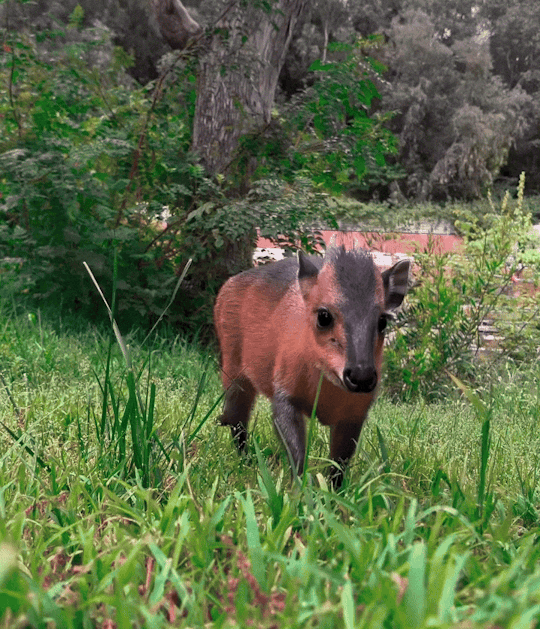
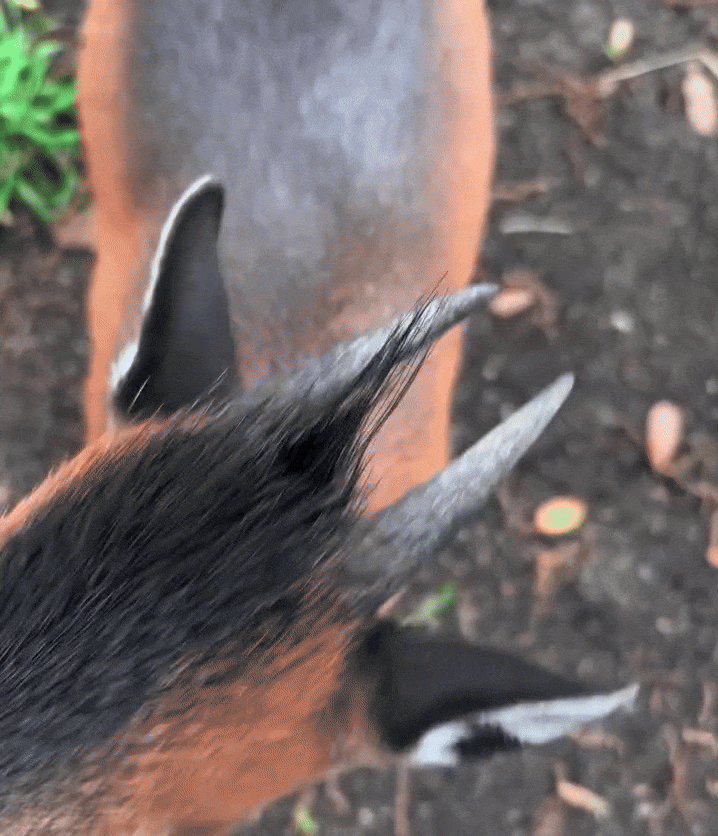

Red-Flanked Duiker 🍄🦌🎋
Please credit if you use my gifs!
#brown#green#nature#animal#deer#duiker#red-flanked duiker#cute#ungulate#small animal#stim#stimmy#stimming#stimblr#sensory#gifset#stim gifs#gifs#fizzy gifs#animal stim#nature stim
19 notes
·
View notes
Text

Red-flanked duiker Cephalophus rufiflatus
Observed by seldom_seen, CC BY-NC-SA
31 notes
·
View notes
Text
me trying to tell the difference between antelope and deer 🗿
#i cannot. there is room in my heart for both#NO CUZ LIKE yeah the more typical antelope and a white tailed deer its obvious#but then you get down to like a mouse deer vs like#a red-flanked duiker?????? tHOSE ARE THE SAME THING how are they not#i love tjem both but i hate calling them the wrong thing
4 notes
·
View notes
Text
Red-flanked duiker (Cephalophus rufilatus). The little slits they have right below their eyes are their preorbital glands, which are seen in many species of artiodactyls and used for scent marking.
#A rather extreme case of those glands are seen in muntjac deer#Thank you so much for the tag!#Duikers#Antelopes
2K notes
·
View notes
Text
Sometimes the smallest antelope give the biggest smiles 😊
Brookfield Zoo
19 notes
·
View notes
Text
Red Flanked Duiker
This species will often follow foraging primates (such as Tantalus monkeys and baboons), feeding on the flowers, fruits, and vegetation that get dropped from the treetops. They are also able to stand upright on their hind legs to reach food that is above their normal reach. Typical of duikers, this species is shy and quickly flees into cover if alarmed. The alarm call is a shrill bark or loud snort.
#red flanked duiker#red flanked duikers#animal#animals#animal fact#animal facts#fun animal fact#fun animal facts#fun fact#fun facts#fact#facts#zoology
9 notes
·
View notes
Text
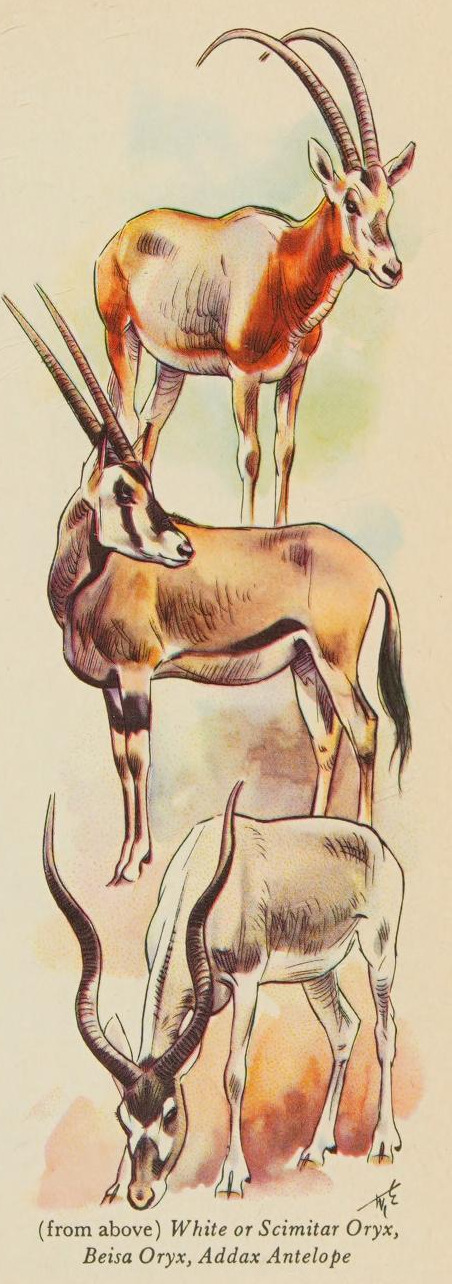
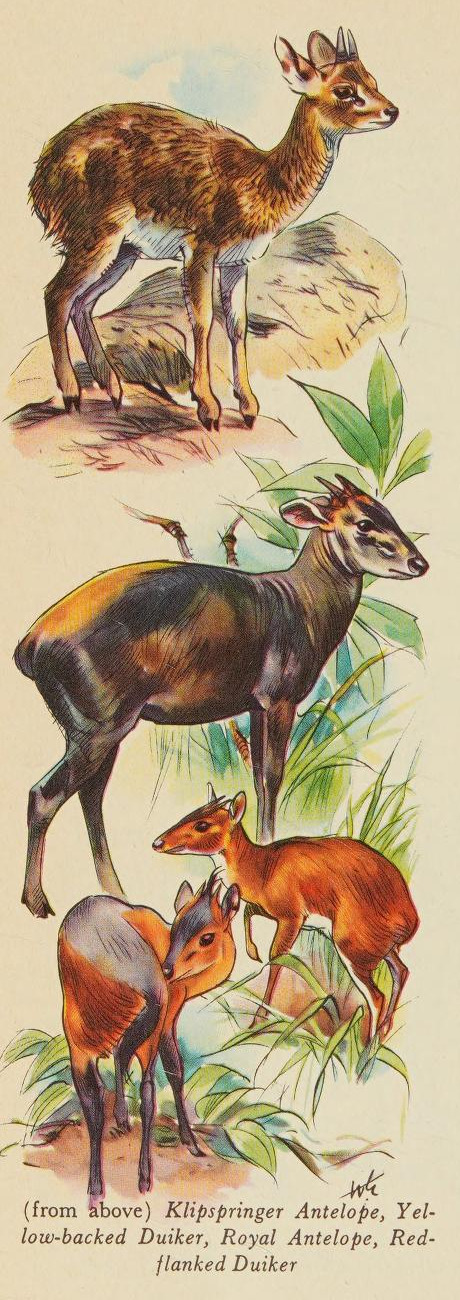
Mammals of the World. Written by Hans Hvass. Illustrated by Wilhelm Eigener. 1975.
#bovids#antelope#oryx#scimitar oryx#beisa oryx#addax#klipspringers#duikers#yellow backed duikers#royal antelope#red flanked duikers#Wilhelm Eigener
242 notes
·
View notes
Text
Pachycephalosaur domes: Function
Welcome back! We last left our heroine (that’s me!) as she gave a brief overview of the history of interpretations of pachycephalosaur domes. We now return to your regularly scheduled program.
However, little discussion was had of the function of the pachycephalosaur dome in this early work, with suggestions limited to the broad category of “armour” (ex: Gilmore, 1924).
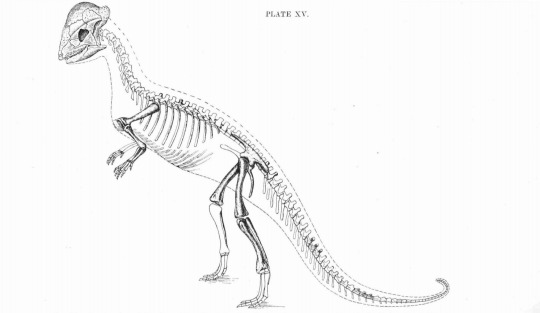
(Image: A skeletal restoration of Stegoceras validum showing pachycephalosaur anatomy as known in 1924. Outlined parts are inferred from comparison with Hypsilophodon. Image from Gilmore (1924).)
The first worker to propose a functional use of pachycephalosaur domes was Edwin Colbert in 1955, who compared the domes to the cranial “bosses” of artiodactyls and suggested that they may have been used similarly in head-butting battles - here used to mean head-to-head smashing contests - over mates.
Galton (1971) thought this was a pretty boss idea, and pointed out that the domes of pachycephalosaurs were made of very thick solid bone. Bone takes a lot of energy to maintain; despite looking like a static, dead rock, it is in fact a living tissue that is constantly remodeling itself (hence why you can repair after a broken bone!). If the domes were just for display, Galton argued that it’d be much more beneficial for them to be hollow. (This would also make them lighter to carry around.)
This still left the suggestion of the dome being used as an anti-predator weapon. Galton argued that this also was unlikely — after all, if something is trying to kill you, why not have a sharply pointed head instead of a dull, rounded one? Finally, Galton pointed out that the neck articulation was rotated to the bottom of the skull, a condition that we’ve seen is extremely rare among animals. He argued that this was an adaptation for transferring stresses away from the brain and into the body after two pachycephalosaurs bonked heads.

(Image: *Bonk*. <Drawings of pachycephalosaur skulls bonking into each other, with arrows showing his interpretation of how forces would be transferred>. From Galton (1971).)
Sues (1978) agreed that the thickening of the skull functioned to reinforce it for use as a battering ram. In order to see whether it had any structures that indicated special adaptations for bonking heads, he cut a pachycephalosaur dome open and looked inside it.
Modern animals that butt heads with each other are, of course, in danger, because the skull contains the brain, which is a part of the body that you generally don’t like getting sloshed around. A completely solid dome, while very durable, might thus not be the best way to go if you’re bonking into things. This is because it would lead to all forces traveling directly into the brain, without absorbing any of the impact. A more springy dome that keeps its strength but can deform would mean that that stress gets reduced. It’s the same reason why modern cars are designed to crumple to keep you safe.
So in order to counter that, modern head-butting mammals have hollow areas on their heads that are reinforced on the inside with bony struts. Here’s an example of that in a Cape Buffalo:
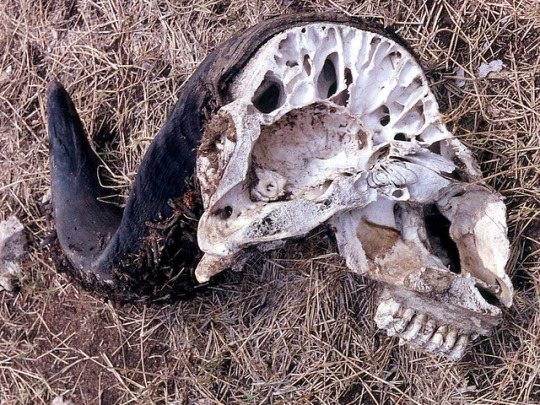
(Photo: The skull of a Cape Buffalo (Syncerus caffer), which has broken open, revealing a complex series of sinuses and body struts under the horns. Source)
So what did Sues find when he cut open the skulls of pachycephalosaurs? See for yourself:
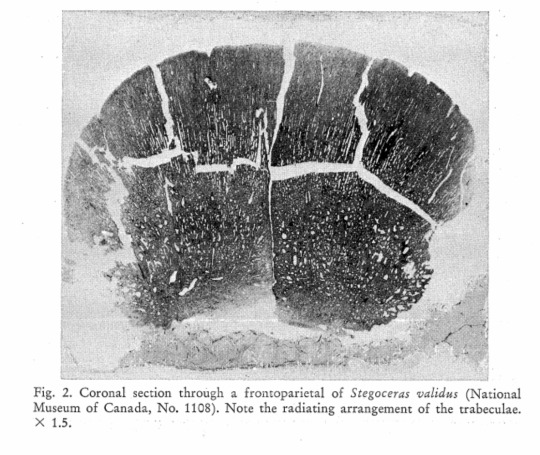
(Image: A thin section through the dome of a Stegoceras validus - this section is cut from “ear to ear”, if that helps you imagine it (though note that their ears weren’t quite in the same place as ours; this is just to help clarify what’s being shown here). I’ll describe anatomically what’s going on in the next paragraph. Image from Sues (1978).)
First things first, those big cracks are not anatomical features; so far as I can tell, they are just cracks in the specimen. What we’re really looking at here are the much smaller bony struts and cavities that radiate away from where the brain would be towards the outside of the skull. Sues termed these radiating trabeculae, and argued that they served a similar function to the sinuses in buffalo. They are not nearly as big as the ones in buffalo, but Sues suggested that differences in brain size and structure might have meant that such protection wasn’t as necessary in pachycephalosaurs.
This idea that the pachycephalosaur skull could resist stresses was elaborated on by Snively and Cox (2008), who, using computer models, demonstrated that point stresses applied to higher-domed skulls would diminish rapidly with distance from the point of contact. They found that flat-headed pachycephalosaur skulls would propagate stresses through their structures far more. Based on these results, they predicted a high occurrence of injury to the surface of the dome.
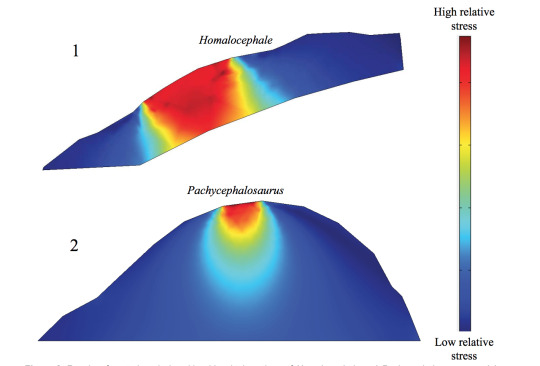
(Image: Biomechanical computer models of the flat-headed Homalocephale and the dome-headed Pachycephalosaurus. The former shows high stresses throughout the “dome”, while the latter shows stresses diminishing near the point of contact.)
Their predictions were confirmed by Peterson et al. (2013), who examined domes across pachycephalosaur diversity for evidence of injury. Fully 22% of specimens observed showed injuries to the frontoparietal dome, and 7% of specimens had 6 or more lesions. This is an insanely high frequency of injury, and lends some support to the idea that they were hitting their heads against something. Injuries were concentrated near the peak of the dome, as might be expected were domes used in butting behaviour; all flat-headed specimens examined lacked head injuries.
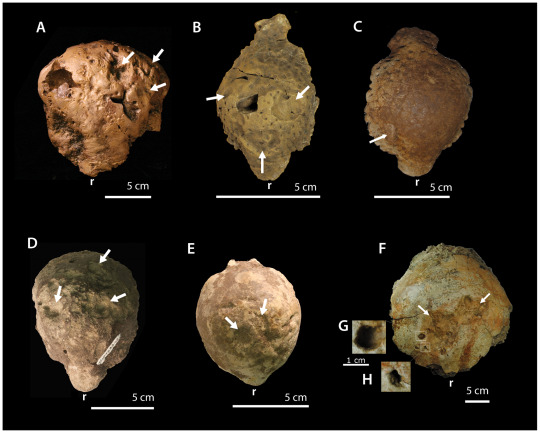
(Image: Six different pachycephalosaur domes, all with surface injuries (indicated with white arrows). Image from Peterson et al (2013).)
Snively and Theodor (2011) offered comparisons to modern head-butting mammals including giraffes, musk oxen, and duikers by examining bone density. Their results showed that pachycephalosaur cranial domes exhibit particularly dense bone superficially but much less dense bone as one moves deeper into the dome, a pattern seen also in head-butting artiodactyls, and suggested that this supports them using their heads to hit things with.
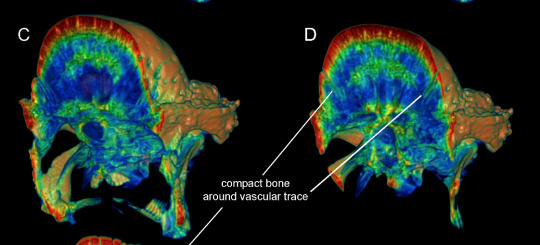
(Image: Scans through the skull of Stegoceras, showing higher bone density in red and lower in blue. Higher-density bone is concentrated towards the outside of the dome, with lower-density bone inside. Modified from Snively and Theodor (2011).)
Modern animals that butt heads typically have broad-flat surfaces (as in bighorn sheep) or otherwise branches or structures to maintain contact (as in ibex, for example). Pachycephalosaurs have neither of these, instead having rounded domes; if two ran at each other, it is easy to image how they might glance off each other and injure their necks. Sues (1978) thus argued that the domed shape might indicate flank-butting (in which animals would ram each others’ sides).
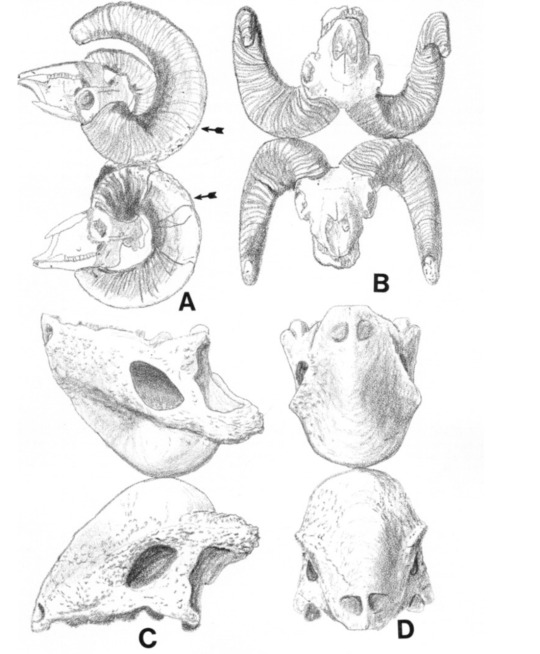
(Image: Problems with pachycephalosaurs bonking heads. Modern bighorn sheep skulls have wide surfaces of contact, while pachycephalosaurs would have only a very small point on the top of a round dome. Image from Carpenter (1997))
This was elaborated upon by Carpenter (1997), who noted that the head-butting hypothesis supposes that the skull and vertebral column act in a straight line to transmit forces through the body (rather than into the neck). Carpenter observed that, though no complete neck is known from a pachycephalosaur, the orientation of the back vertebrae and of the socket on the skull necessitate a gently S-curved neck and back, as in most ornithischians. As such a curved neck would transmit stresses diagonally on the spinal column, it risks breaking the neck. Today’s head-butting mammals solve this problem by having tall spines on their neck and back vertebrae, but these are not present in pachycephalosaurs.
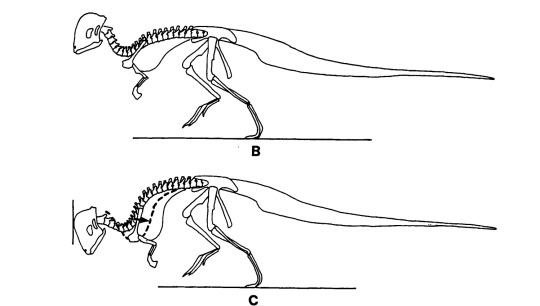
(Image: Schematic drawing of a pachycephalosaur skeleton, showing S-curved neck and transmission of stress shear-wise to vertebral column. Modified from Carpenter (1997).)
He agreed that flank-butting was a more likely use of pachycephalosaur domes, pointing to similar behaviour in modern African antelope. Finally, Carpenter pointed to the wide ribcage of pachycephalosaurs as possible evidence of thickening the torso to better protect against butting behaviour.
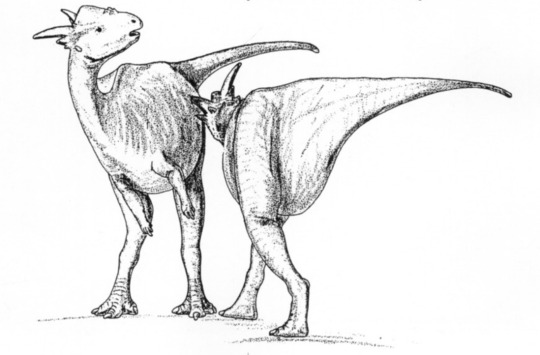
(Image: Drawing of two pachycephalosaurs butting each others’ flanks. Modified from Carpenter (1997).)
Goodwin et al (1998) agreed about flank-butting, and also believed that the structure of the dome would not have offered protection against stresses as the trabeculae were not interconnected. Instead, they interpreted the structures instead as artefacts of rapid growth of the dome.
Bony reinforcements of the tail are pretty common in dinosaurs; they are most extensive in the “duck-billed” hadrosaurs, in which the tendons of the back have turned to bone and effectively make the entire back and tail stiff and unable to move.
Pachycephalosaurs have similar-looking structures on their tails, and Goodwin et al. suggested that the reinforced tail of pachycephalosaurs may have served a role in flank-butting behaviour, offering that it may have been used as a defensive weapon against other pachycephalosaurs.
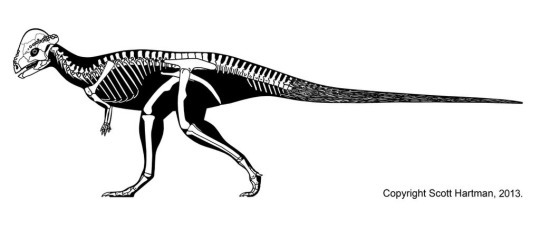
(Image: Skeletal drawing of Stegoceras. Note the complex “basket” of bones reinforcing the tail. Image by Scott Hartman @skeletaldrawing.)
However, the idea of the tail as a defensive weapon was rejected by Brown and Russell (2012). These authors demonstrated that, amazingly, the “basket” of bones reinforcing the tail are not tendons, but instead the divisions between the individual muscle blacks that have turned to bone! This is a condition that’s unknown in any other tetrapod (though it’s present in some fish). Due to the location of the ossifications within the muscles rather than the skin, these authors argued that it would not be useful as a weapon. These authors instead suggested that the the tail served to brace the body in a tripodal stance during flank-butting, an idea first proposed by Maryańska and Osmólska (1974).
The first major objection to be raised against generalised butting behaviour in pachycephalosaurs was by Goodwin and Horner (2004), who sliced into the domes of pachycephalosaur skulls of different ages. Building off of work done by Goodwin et al. (1998), they argued that the “radiating trabeculae” that had been cited by previous authors as being adaptations for reducing strain on the brain are instead temporary features associated with the rapid growth of the skull and disappear as the animal ages, and that the shape of the adult dome was ill-suited for dissipating stress.
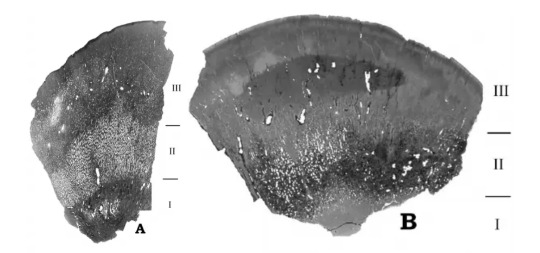
(Image: Thin sections of two pachycephalosaur domes, the left from a younger individual, the right from an older individual. Stage II (the less dense, spongier bone) is propotionally thicker in the younger individual. Images are not to scale. From Goodwin and Horner (2004).)
The authours instead argued that pachycephalosaur domes functioned as species-recognition characteristics, as they were apparently not sexually dimorphic (to be discused in a future post, which will be linked here).
This idea received criticism for failing to address why animals would evolve such thick and dense structures if they were just for display, and I confess I don’t buy the idea at all. . Lehman (2010) also took issue with the characterisation of the dome histology, concluding that the radial structure of the bone was present even in the most superficial, densest bone zone, albeit with a decreased amount of vascularity; and that the less compact, vascular bone was maintained at least until the individual attained adult size. He further noted that trabecular struts of a form similar to those found in pachycephalosaur frontoparietal domes are strongest against compressional stress along their long axis, consistent with high strength in pachycephalosaur domes.
Longrich et al (2010) argued that the dome could not possibly have functioned in species recognition, because dome shape is not significantly different between different species — an observation that, to my view, is an extremely convincing argument against the “species recognition” idea. These authors also pointed out that some degree of asymmetry was not uncommon in pachycephalosaur domes, and noted that this is a common trait of featured which have been sexually selected (both in display structures and intra-specific weapons).
This was a bit of a longer post this week, but I wanted to make sure I had a good overview of different proposed functions of the dome. This series will conclude next week with a look into who had the dome, and finally what I think they were doing with it! A link to that will be >here< once it’s up.
427 notes
·
View notes
Note
Your quiz was super fun and I got an anteater! I was wondering what other animals would fall under an INFP personality?
i’ve realized i’m getting a lot of requests from INFPs so this seems like the perfect question to make a little list of my top 100 animals i think of for INFPs! i won’t go into too much detail with these, this might just be a good starting place for people to ask specific questions about forms!
macropodidae - tree kangaroo (independent, polite, private, go with the flow, non-planner, even-tempered, unobtrusive and passive, shy but tactful) - whiptail wallaby (social and gets anxious without support, generous and nurturing yet needs freedom, nervous planner, has a competitive streak) - red-necked wallaby (socially flexible, happy alone or with friends, anxious planner, doesn’t like commitments, has a competitive streak) - pademelon (socially flexible, happy alone or with friends, slow-starting and procrastinating, self-doubting, habitual and routine)
phalangeriformes - ringtail possum (attached to loved ones but wary of strangers, observant, specialized and likes to find a niche, still willing to be flexible, boundary-keeping and can be defensive) - brushtail possum (slow to trust but deeply loyal and affectionate, to loved ones, habitual and routine-oriented, low energy and corner-cutting, focused solely on own task, sensitive but can be assertive) - striped possum (independent and private, only enjoys close friends, polite and tactful, incredibly curious and inquisitive, active, obsessive, can be stubborn) - pygmy possum (very anxious and sensitive, likes to keep busy but isn't assertive or domineering, alert and observant, planners and perfectionists) - mahogany glider (independent but like having a tight-knit group, values privacy and can be defensive, likes to stay busy, very focused and efficient, routine-oriented and anxious with change)
other marsupials - greater glider (independent and private but socially tolerant, quiet and passive aggressive, routine-oriented and likes to have a plan, specialized and sensitive to change, dedicated and focused) - kowari (socially flexible; comfortable being independent but also has a close-knit group, specialized but extremely opportunistic and passionate in their niche, observant and alert) - opossum (independent and not easily attached to others, adaptable, opportunistic, passive and sensitive, defensive and prone to bluffing, laidback and easy-going, curious)
eulipotyphla - hedgehog (independent and socially selective, slow to trust but incredibly loyal, anxious and conflict-avoidant, likes being busy but easily discouraged)
xenartha - hairy armadillo (independent but socially tolerant, plans ahead, goal-driven and determined, sensitive and habitual, unobtrusive, cautious, willing to be defensive, communicative) - nine-banded armadillo (habitual people who like to have a plan, also capable of being adaptable and not too fussed by change, socially tolerant and even-tempered, passive, needs personal freedom) - silky anteater (independent, peaceful, quiet and private, low energy and slow and steady, routine-oriented and loyal, dutiful, thorough, passive, anxious and prone to burn out) - tamandua (introverted and values alone time, private, independent, habitual and routine-oriented, tends to be stubborn, intuitive and observant, conflict-avoidant and dislikes change)
coendous - brazilian porcupine (independent and self-supporting, works best alone, still rather tolerant and friendly, confident in self, dutiful but slow and steady, go with the flow and flexible) - mexican tree porcupine (independent and self-supporting, tolerant and socially flexible, works best alone, calm, very driven and likes to complete things, confident and direct, adaptable)
pholidota - indian pangolin (introverted and independent but tolerant, shy and conflict-avoidant, specialized and likes staying in their niche, particular, intuitive and focused, slow and steady workers) - tree pangolin (introverted and independent but tolerant, very private, specialized and likes staying in their niche, laid-back, patient, flexible, not terribly organized, dedicated, stubborn, defensive when pressed) - ground pangolin (introverted and independent but tolerant, specialized but willing to take life as it comes, very private, dedicated and focused, resilient, laid back, quiet)
monotreme - platypus (independent and like to do their own thing, perceptive and observant, particular, conflict-avoidant, focused and diligent, can be sensitive, perfectionists, anxious streak)
lutrinae - marine otter (introverted but can enjoy socializing with a select few, non-judgmental and playful, cooperative, route-oriented, procrastinators and unambitious, confident, flexible and adaptable, unbothered) - north american river otter (sociable and playful, still enjoy their alone time, prone to loneliness, intuitive and expressive, easy-going, self-assured, loyal, curious, affectionate, carefree) - eurasian otter (independent but friendly and open-minded, doesn’t like to commit, values warmth and compassion, communicative, boundary-keeping, intuitive and perceptive, easily distracted, passionate, spontaneous)
giraffidae - giraffe (social but individualistic, values freedom and independence, caring, particular and fickle, expressive, patient and relaxed, can be confident and competitive, more so values a calm environment) - okapi (independent but socially tolerant, intuitive and empathetic, habitual, patient and diligent, cautious, defensive and proud when pushed, stubborn, anxious, guarded)
tapirus - baird’s tapir (introverted but values close bonds, guarded, private, loyal, slow and steady, conflict-avoidant, habitual and routine-oriented, committed and persistent, resilient, curious) - mountain tapir (introverted but values close bonds, very anxious and private, boundary-keeping, sensitive and defensive when pushed, resilient and enduring, conflict-avoidant, curious) - malayan tapir (introverted but values close bonds, thick-skinned, guarded and boundary-keeping, steady workers, routine-oriented but adaptable, conflict-avoidant, observant, determined)
bovidae - red-flanked duiker (introverted and independent, is more loose-bonding and private, adaptable but prefers routine, cautious, wary, boundary-keeping, reactive, very anxious, conflict-avoidant, secretive) - blue duiker (introverted but attached to close friends, loyal, wary of strangers, boundary-keeping and defensive, adaptable, conflict-avoidant, observant, anxious and easily stressed) - kéwel (very introverted and private, overall tolerant and easygoing, values small group of friends, passive, habitual and routine-oriented, withdrawn, non-judgmental, quiet, tactful) - lesser kudu (introverted but socially tolerant, easy-going and gentle, empathetic, conflict-avoidant, sensitive, observant, private, opportunistic, enduring, typically polite but has a stubborn streak) - sitatunga (introverted but values friends and can be prone to loneliness, habitual, conflict-avoidant, passive, communicative, slow to trust, more loose-bonding, anxious, quiet, tactful) - klipspringer (independent but attached to their group of friends, loyal, empathetic and affectionate, assertive and willing to stand up for self and others, protective, tactful and cautious - but stubborn) - cape bushbuck (independent and introverted but tolerant, values close friends and is selectively loyal, unassertive, easygoing, passive, habitual and needs stability, quiet, tactful and polite, mellow)
cervidae/moschidae - tufted deer (introverted and independent, prefers one-on-one interactions, proud streak, assertive but prefers to be conflict-avoidant, habitual, sensitive and anxious, observant and aware, stubborn, private, tactful) - marsh deer (introverted but socially tolerant, shy and sensitive, private and independent, wary, guarded, easily stressed, conflict-avoidant, habitual and routine-oriented, specialized, peaceful) - musk deer (independent and introverted, socially selective, slow to trust, guarded, boundary-keeping, easily stressed and overwhelmed, conflict-avoidant, shy, habitual, low energy and work ethic)
strigiformes - barn owl (introverted but socially tolerant, loyal to loved ones, habitual though adaptable to change, plans ahead, perceptive and aware, passive, empathetic and understanding, patient, shy, anxious streak) - boreal owl (very introverted and values quiet time, dutiful and dedicated, patient, focused and perceptive, cautious, aware, private, anxious, plans ahead, tactful and polite) - elf owl (socially flexible but selective, loyal and communicative, values peacefulness and cooperation, unobtrusive, plans ahead, resourceful and opportunistic, patient, anxious and sensitive)
galliformes - chukar partridge (socially flexible and loyal, understanding, empathetic, protective, boundary-keeping, adaptable and hardy but insecure, open, honest and expressive, curious and opportunistic) - gambel’s quail (introverted but socially flexible, affectionate and committed, anxious, passive, sensitive, detail-oriented, perfectionistic, conflict-avoidant, averse to change, more confident in comfort zone) - montezuma quail (introverted but social, prone to loneliness, shy and private, conflict-avoidant, vulnerable to stress, routine-oriented, habitual, open-minded, slow and steady workers, dutiful)
ursidae - sun bear (independent and introverted but tolerant, opportunistic, intuitive, conflict-avoidant, willing to be defensive and assertive if pushed, adaptable and flexible, non-planners, self-assured) - moon bear (introverted and socially selective, tends to be loose-bonding, communicative, go-with-the-flow, adventurous, reactive, opportunistic and impulsive, low energy, reserved, open-minded) - sloth bear (very independent and introverted, thick-skinned, habitual, lost in their own world, adaptable, low energy, confident, calm, tolerant, dedicated but the slow and steady type)
wild canidae - maned wolf (independent, autonomous, loyal and dependable to loved ones, values freedom, guarded and private, communicative, boundary-keeping, defensive, flexible, curious, routine-forming, anxious) - raccoon dog (introverted but devoted to loved ones, cooperative, slow to trust, selfless, calm and even-tempered, conflict-avoidant, unobtrusive, quietly passionate, hard-working and dutiful) - culpeo (independent and socially selective, adaptable, spontaneous and not inclined to plan, communicative, generalists who don't like to be pinned down, opportunistic, dutiful, curious) - patagonian fox (introverted and independent, socially selective, dutiful, committed, close-bonding, cooperative, dependable, habitual, a generalist, corner-cutting, self-assured, observant) - gray fox (introverted and independent, appreciate company of close few, loyal and caring, empathetic, cooperative, cautious, adaptable, plans ahead, tactful and polite, compliant, patient, slow to trust)
domestic canidae - chow chow (introverted and socially selective, loyal to few friends, empathetic, slow to trust, assertive and defensive, private, stubborn, low energy, self-assured, serious, blunt) - shar pei (introverted and socially selective, loyal to select few, empathetic and caring, independent, stubborn streak, boundary-keeping, assertive and private, low energy, devoted, reserved) - french bulldog (sociable but low energy, friendly and approachable, caring, loyal and devoted, prone to loneliness, stubborn streak, curious and playful, protective, emotional, strong-willed, security-seeking) - lhasa apso (introverted and socially selective, loyal to loved ones, communicative, caring but reserved, stubborn, determined, protective, confident, low energy and calm, possessive, opinionated) - tibetan terrier (introverted and socially selective, loyal and affectionate towards loved ones, slow to trust, low energy, observant and aware, cautious, gentle and even-tempered, reserved, sensitive, can be stubborn) - cavalier king charles spaniel (sociable but low energy, friendly and warm, approachable, relaxed and easy-going, tolerant, long-fused, people-pleaser, gets stressed and burnt out easily, dependable, dutiful, loyal and empathetic)
felidae - serval (very introverted and independent, highly specialized, intuitive, willing to be adaptable, conflict-avoidant, patient, efficient, focused and obsessive, manipulative, aware, confident, tactful, perfectionistic) - jaguarundi (independent, socially tolerant but also retains an essential degree of privacy, very passive and unassertive and tactful, communicative, resourceful, cautious and intuitive, looks before they leap)
feliformia - brown hyena (socially flexible but independent and self-reliant, resourceful, curious and dedicated, adaptable, stubborn, conflict-avoidant, prone to manipulation and bluffing, expression, self-confident, competitive) - striped hyena (introverted and socially tolerant, more independent and loose-bonding, reserved, passive, conflict-avoidant, versatile, mediators, impulsive and not a planner, passive-aggressive, amicable) - fossa (introverted and independent, expressive and communicative, cooperative when it suits their ambition, problem solvers, quick minds, specialized, on the confident side)
viverridae - african civet (introverted and independent, conflict-avoidant, adaptable and resourceful, guarded, private but willing to be communicative, hardy, self-assured, stubborn, persistent, self-preserving) - common palm civet (independent and introverted, private, guarded, tactful and unobtrusive, adaptable but prefers to be specialized, flexible, non-planners, routine-oriented, will be defensively manipulative) - masked palm civet (introverted and independent, private, guarded, adaptable and resourceful, impulsive and spontaneous, honest, defensive and reactive, somewhat insecure, quietly competitive, boundary-keeping, curious) - common genet (independent and introverted, guarded, defensive and private, adaptable, communicative and expressive, self-assured, patient and calm, passive-aggressive, hardy, self-preserving) - cape genet (independent and introverted, boundary-keeping, tactful and cautious, expressive, willing to be defensive, adaptable, self-assured and typically confident, assertive) - binturong (independent and introverted, patient, long-fused, procrastinator, self-assured, expressive and communicative, flexible, calm and carefree demeanor, hardy, stubborn, approachable)
serpentes - green tree python (independent and withdrawn, passive, observant, very sensitive, internal, private and guarded, conflict-avoidant, habitual and desires a plan, low energy) - children’s python (introverted and independent, still passive but more anxious, more opportunistic and willing to seek out opportunities, low energy, insightful, corner-cutting but a perfectionist with the result) - rough-scaled python (independent and withdrawn, very habitual, passive, and low energy similar to the green tree python, secretive and private, low energy, extremely easy-going and patient) - asian rock python (very independent and introverted, passive, low energy, hard workers but prone to burnout and abandoning projects, conflict-avoidant, easy-going and submissive, prone to bluffing, secretive, sensitive) - green anaconda (independent and introverted, loose-bonding, detached, socially selective, dedicated and focused, prone to burnout, patient and low energy, can procrastinate, habitual, generalists, value completion) - corn snake (independent and introverted, passive, patient, defensive and cautious, low energy, procrastinator, highly adaptable and flexible, observant and perceptive, compliant, apathetic, self-preserving) - flying snake (introverted and independent, loose bonding, socially tolerant, sensitive and observant, conflict-avoidant, specialized, inflexible, persistent and determined, withdrawn, unobtrusive, cautious) - ringneck snake (introverted and independent but socially tolerant, agreeable, communicative, conflict-avoidant, the type to plan ahead, habitual, cooperative, patient, opportunistic, low energy, focused)
insecta - atlas moth (passive and perceptive, conflict-avoidant, intuitive, introverted but socially tolerant, compliant and unobtrusive, patient, unambitious, low energy and relaxed) - death’s head hawkmoth (passive and perceptive, independent and easily drained, spontaneous, flexible and persistent, intuitive, capable of manipulation, anxious, withdrawn, polite but can be unreliable) - silkworm moth (passive and perceptive, extremely specialized and habitual, gets very anxious outside of their comfort zone but within it is confident and productive) - muslin moth (passive and perceptive, more generalists and not interested in being specialized, very sensitive to their environment, naturally curious but doesn't like permanent change) - oak eggar (passive and perceptive, happily adaptable and flexible and not bothered by change, active and likes to keep busy, curious and committed to their interests) - luna moth (passive and perceptive, independent and introverted but tolerant, polite, conflict-avoidant, low commitment, perfectionists, scattered work ethic, modest, secretive, anxious, easily stressed) - ladybug (socially flexible; loves having a friend group but needs independence, spontaneous and fickle, curious, cautious but adaptable, erratic work ethic, impatient, sensitive) - orchid mantis (extremely independent and introverted, patient and passive, quiet, low energy, easy-going and compliant, specialized, observant and aware, idealistic, sensitive)
anura - wood frog (quiet, sensitive, habitual, though willing to be competitive and opportunists, highly adaptable and self-preserving) - spadefoot frog (quiet, sensitive, willing to a degree to be competitive and opportunists, very withdrawn, anxious and stressed easily, habitual) - spring peeper (generally withdrawn and sensitive, though importantly competitive and opportunists, determined and driven with goals, wants to impress others)
urodela - tiger salamander (introverted and independent, socially tolerant and easy-going, passive, open-minded, private, a little awkward, anxious, quietly competitive, opportunistic, security-seeking, sensitive) - fire salamander (introverted and independent, extremely shy and secretive, unobtrusive, anxious, conflict-avoidant, particular and sensitive to their environment, habitual, amicable, passive, planners) - spotted salamander (introverted and independent, loose-bonding, self-focused and preserving, determined, good work ethic, habitual and routine-oriented, adaptable, straightforward, sensitive to surroundings) - hellbender (introverted and independent, boundary-keeping, private, observant and alert, self-preserving and focused, habitual, doesn't like change, opportunistic, self-assured)
aquatic mammals - harbor porpoise (introverted but socially tolerant, loyal to a select few, peaceful, sensitive and timid, conflict-avoidant, wary, quietly competitive, obsessive, curious, cooperative and dependent, anxious, habitual) - finless porpoise (introverted and shy, tends to be independent, gentle, patient and cautious, curious but look before they leap, adaptable, slow-starting but determined and focused, sensitive) - minke whale (introverted but socially flexible, gentle and approachable, independent, passive, laid-back, flexible, reserved, conflict-avoidant, patient, intuitive, self-assured, long-fused, enduring) - beluga whale (sociable, communicative, adaptable and flexible, patient, light-hearted and easy-going, curious, cooperative, communicative and expressive, security-seeking, agreeable) - manatee (introverted but socially tolerant, generally aloof, self-assured, intuitive, sensitive and passive, flexible, low energy, peaceful, non-committal, agreeable, polite, indecisive, long-fused)
79 notes
·
View notes
Photo

Red-flanked duiker Cephalophorus rufiflatus
Observed by fl66, CC-BY-NC
1 note
·
View note
Note
I have no knowledge of deers I will classify them all as “deers”. Sure some look different but they are all same ish.
YEAH like of it has 4 legs and antlers it's deer or deer adjacent to me tbh. antelope? yeah sure. giraffe? close enough. heck not even all species of deer have antlers, water deer don't have any at all, just tusks
I do wanna learn the difference between them just for "not mislabeling them"s sake you know but it's VERY HARD when some of them look so similar. the first one is a species of antelope, a red-flanked duiker, and the second is a mouse deer


how on EARTH are these completely different species im 😭
4 notes
·
View notes
Photo



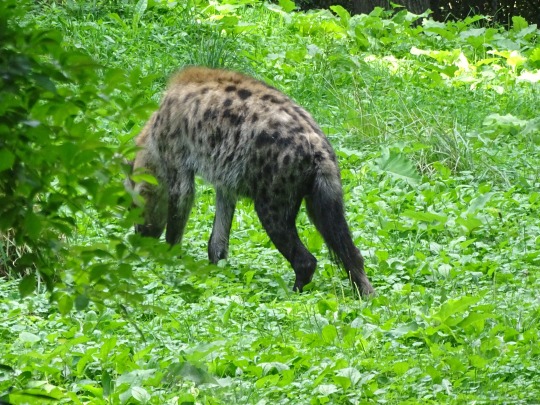


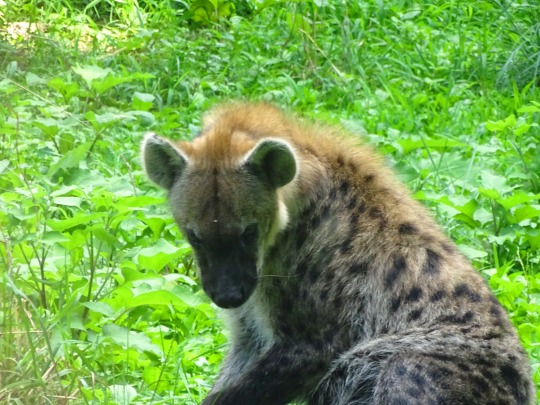
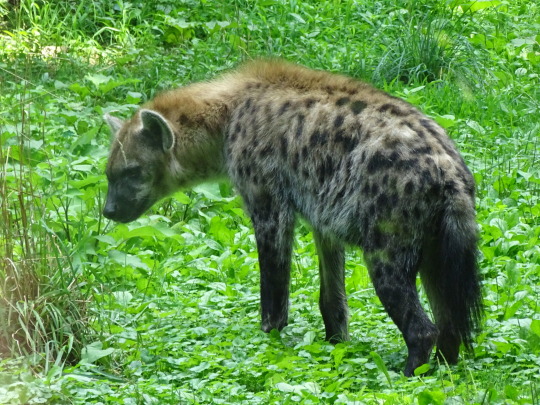
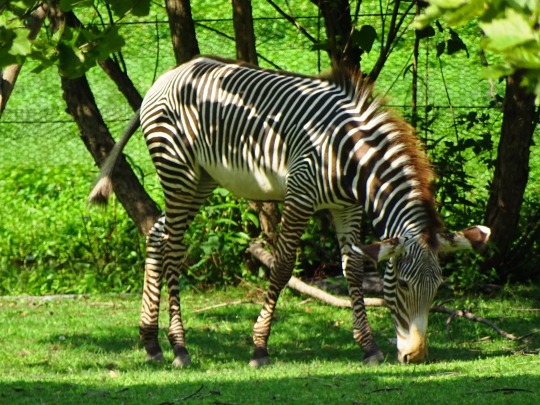

Bronx Zoo, New York City (No. 38)
African Plains allows visitors to walk past lions, African wild dogs, and Grévy's zebras, and see herds of Thomson's gazelles, lowland nyalas, and slender-horned gazelles sharing their home with lesser kudus, marabou storks, grey crowned cranes, blue cranes, and red-flanked duikers. Hybrid giraffes (Baringo × reticulated giraffe) roam nearby. The exhibit originally opened in 1941 and was the first in the country to allow visitors to view predators and their prey in a naturalistic setting as well as allowing large predators such as lions to be exhibited cage-free. This success was achieved through the creation of a series of deep moats, a set-up which can still be found at the zoo today. The wild dogs, however, can be viewed close-up from a glass-fronted viewing pavilion. The zoo has bred their lions on multiple occasions, including one male and two females born in January 2010 and three males and one female born in August 2013. The zoo, in partnership with the NY Daily News, held a contest to name the 2010 cubs, which made their public debut in April 2010. The winning names were Shani, Nala, and Adamma. The 2013 cubs were named Thulani, Ime, Bahata, and Amara and the three males can still be found on-exhibit at the zoo. The Carter Giraffe Building, a section of African Plains, features indoor/outdoor viewing of the zoo's giraffes and southern ostriches (Struthio camelus australis), and is also home to spotted hyenas, common dwarf mongoose, and southern white-faced owls. In June 2009, two aardvarks imported from Tanzania joined the exhibit. In September 2010, the pair gave birth to a male named Hoover, the first to ever be born at the zoo. In 1924, the zoo became the first in North America to exhibit the species.
Until 2009, the southwestern corner of African Plains was home to the endangered Arabian oryx and blesbok. Due to budget cuts and the unpopularity of the species with visitors, they were phased-out of the collection. This section of the exhibit remains empty. In 2017 they received two baby cheetahs from the San Diego Zoo. Cheetahs are now part of their animal encounter programs. They were replaced by the hyenas.
Source: Wikipedia
#Bronx Zoo#my favorite zoo#African Plains#spotted hyena#Grévy's zebra#flora#fauna#nature#animal#Coretta#zebra#New York City#USA#oudoors#meadow#grass#tree#light and shadow#free attraction#travel#summer 2018#original photography#young zebra#cityscape#tourist attraction#landmark#Bronx
2 notes
·
View notes
Text
Baby duiker arrives at the Charles Paddock Zoo
Baby duiker arrives at the Charles Paddock Zoo
–Zoo Director Alan Baker has announced the arrival of a new baby at the Charles Paddock Zoo. The baby Red Flanked Duiker was born on Jan. 22, at the Charles Paddock Zoo. Both baby and mom are doing well, as mom continues to care for her little girl, according to Baker. Although the baby hasn’t ventured out into the public viewing area yet, zookeepers say they predict it will happen very soon.
The…
View On WordPress
0 notes
Text
Baby duiker arrives at the Charles Paddock Zoo
Baby duiker arrives at the Charles Paddock Zoo
–Zoo Director Alan Baker has announced the arrival of a new baby at the Charles Paddock Zoo. The baby Red Flanked Duiker was born on Jan. 22, at the Charles Paddock Zoo. Both baby and mom are doing well, as mom continues to care for her little girl, according to Baker. Although the baby hasn’t ventured out into the public viewing area yet, zookeepers say they predict it will happen very soon.
The…
View On WordPress
0 notes
Text
WHY YOU MUST VISIT KANO TODAY
Kano State is located in North-Western Nigeria and created on May 27, 1967 from the old Northern Region. It is bordered
to the north-west by Katsina State and to the north-east by Jigawa State, then to the south-east by Bauchi State and the south-west by Kaduna State. Jigawa State was carved out of Kano State in 1991.
Kano had about 10 million people according to the 2006 census figures, and 44 local government areas which comprise of the following: Fagge, Dala, Gwale, Kano Municipal, Tarauni, Nassarawa, Kumbotso, Ungogo, Dawakin Tofa, Tofa, Rimin Gado, Bagwai, Gezawa, Gabasawa, Minjibir, Dambatta, Makoda, Kunchi, Bichi, Tsanyawa, Shanono, Gwarzo, Karaye, Rogo, Kabo, Bunkure, Kibiya, Rano, Tudun Wada, Doguwa, Madobi, Kura, Garun Mallam, Bebeji, Kiru, Sumaila, Garko, Takai, Albasu, Gaya, Ajingi, Wudil, Warawa, and Dawakin Kudu.
(adsbygoogle = window.adsbygoogle || []).push({});
The state has a lot of tourist attractions, and the following are some of them:
Tiga dam/Rock Castle: Tiga dam is among the best attractions within the state of Kano where fishing activities and boating take place. At the far end of the dam is Rock Castle Hotel which was purposely built to accommodate Queen Elizabeth and her entourage during her visit to Nigeria in 1960.
Kano Central Mosque: This is located within the Emir’s Palace – a fascinating architecture constructed in the 15th century. Although it has gone through series of modifications, the masterpiece architectural design still bears the hallmark of Arabic influence and culture.
Kurmi market: This market was instituted during the trans-Sahara slave trade when Emir Muhammadu Rumfa was on the throne over 400 years ago. It is the oldest public market in northern Nigeria and renowned for traditional wares such as carvings, calabashes, ancient jewelries, brassworks, leather products, and pottery among other things.
Kofar Matar dyeing pit: The local natives in Kano State dyed clothes as their traditional work, and the places where they dyed the fabrics can still be seen today. The pits are still operational in some other places, and here tourists can learn the art of cloth-dyeing and designs being carried out in the dyeing pits.
Dala Hills: The Dala hills is where the first settlers in Kano dwelt when they first arrived the city thousands of years ago, and the first inhabitants used the hills to model their housing and villages. The hills still retain tourism values that visitors will find fascinating anytime they visit the hills in Kano.
Kano Walls: The Kano city walls was constructed in the 14th century and is 14 km radius from the centre of the city. It provided protection against marauders and external aggression in the olden days, and served as defensive landmarks on which the people relied upon for safety from attackers.
(adsbygoogle = window.adsbygoogle || []).push({});
Gidan Rumfa: This is the present palace of the emir and built in the 13th century during the reign of Emir Muhammadu Rumfa. It is an aristocratic complex with various facilities and sections that told of enduring edifices in an expansive landscape. There is also a mosque within the palace grounds.
Gidan Makama House: This used to be a palace of the emir of Kano, but now used as a museum to tell the story of the Hausa people in Kano. The museum now tells the history of the people from the 9th to 20th century period, including the Jihad period and the British invasion of 1901. This museum is a must-see for every tourist to Kano; and tourists might also want to check out Gidan Dan Hausa which is also the Kano State museum.
(adsbygoogle = window.adsbygoogle || []).push({});
Mallam Kato Square: This square in Kano metropolis is a recreation centre erected on a piece of land initially used by a Quranic mallam who was displaced by British colonial masters. The embattled mallam prophesied that no buildings would be erected on the land and today, it has become a public square for people to carry out social activities.
Buturiya wetland game reserve: This game reserve is 40 kilometres distance from Hadejia. It is a place to watch migrant birds and a rich sanctuary for pelicans, knob-billed goose, yellow-billed stork, grey hornbill, and white-faced duck among others.
(adsbygoogle = window.adsbygoogle || []).push({});
There is also the Falgore game reserve which is a 1,000 square kilometre reserve established in 1949 in the southwestern part of Kano along Jos road. Here visitors can see various wildlife such as jackal, leopard, serval, hartebeest, bush baby, spotted hyena, buffalo, warthog, oribi, red fronted gazelle, red flanked duiker, bushbuck, patas monkey, green monkey etc.
Other attractions: Other attractions in Kano State are the Minjibir weaving centre, Dawakin Tofa pottery, Audu Bako zoological garden, Kusalla dam and fishing centre, Roxy amusement park, Park Dawakin Kudu, Murtala Muhammed Library, Kajuru Castle, and Challawa Gorge dam among others.
READ MORE ON:
(adsbygoogle = window.adsbygoogle || []).push({});
from Blogger http://ift.tt/2nsMqqL via IFTTT
0 notes